#ts’msyen
Text
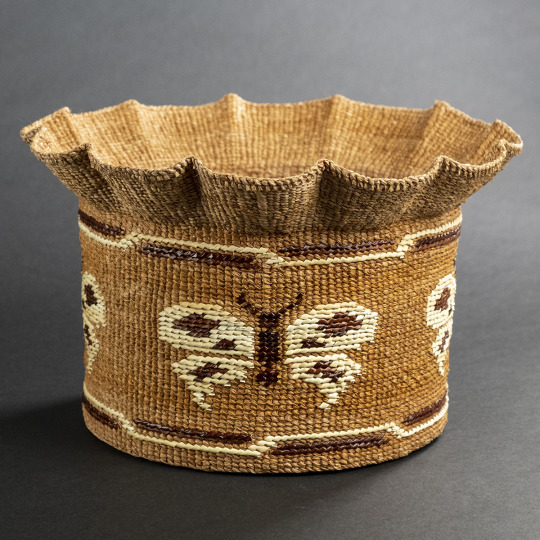
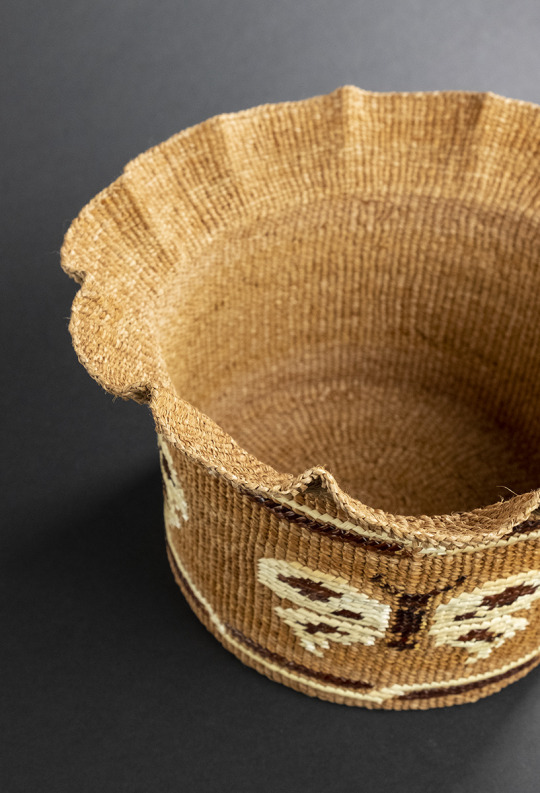
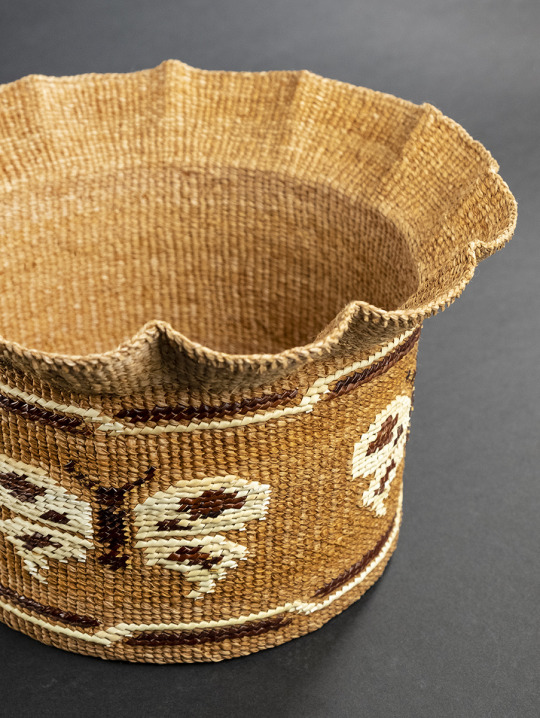
Butterfly Basket
Kandi McGilton (Ts’msyen)
red cedar bark, canary grass, maidenhair fern. 6.13” x 9.63” x 9.63”
#kandi mcgilton#ts’msyen#tsimshian#weaving#baskets#indigenous art#native art#first nations art#ndn art
47 notes
·
View notes
Text
Here’s a podcast episode about our language group before COVID.
https://podcasts.apple.com/us/podcast/tsimshian-language-revitalization-with-the-juneau/id1496876900?i=1000476091840
0 notes
Photo


Nighthawk
Shawn Aster
from the website:
“Tsu’u tsm’aatk” is the Ts’msyen word for ‘Nighthawk’. The mythological character of the Bat appears in a story with Owl, Hawk and Raven. In this myth, these animals are engaged in a war with the mighty Thunderbird. They gather at the beach and use pitch and alder wood to create an artificial whale, which is Thunderbird’s favorite meal. This floating Whale was used in the battle to outsmart the Supernatural Bird and the Warriors succeeded in their mission.
50 notes
·
View notes
Text

Ama g̱a̱nłaak nsipsiipnsgu, John di waayu. Ts’msyenu dił, gisbutwada di hoksgu. Nda wila waalsm. - Good morning my friends, my name is John, I’m Ts’msyen, a member of the Killerwhale clan, how are you all doing?
Taken a long time ago, as this is a very young Jade, taken at the pumpkin patch, Nikon FM2n, I am going to guess either 85/2 or 105/2.5, but leaning towards the 85mm, and this is on ILFORD FP4+.
Image created on the unceded and ancestral lands of q̓ic̓əy̓ (Katzie) First Nations
Opening statement made in Sm’algya̱x, the ancestral language of the Ts’msyen First Nation of which I am learning.
#believeinfilm#shootfilmbenice#staybrokeshootfilm#muchgrainverycommunity#film#canadianfilmphotographers#analog#tsimshianphotographer#nikon fm2n
11 notes
·
View notes
Text
Indigene Künstlerin bietet eine originelle Sichtweise auf die Entkolonialisierung und die Wiedergutmachung der Vergangenheit
Patricia June Vickers ist Malerin, Trauma-Heilerin, Mitglied des Adler-Clans aus dem Dorf Gitxaala im Nordwesten von B.C. und ein Inzest-Opfer, das sich nicht von der Kirche als Institution, sondern von den Lehren Jesu inspirieren lässt.
Angesichts ihrer einzigartigen Geschichte sind die Schilderungen der Ts’msyen-Frau über Internatsschulen, Entkolonialisierung und christliche Symbole…

View On WordPress
0 notes
Text
This Week in Indigenous Rights 2018–10–29
This Week in Indigenous Rights 2018–10–29
Author(s): Scott Douglas Jacobsen
Publication (Outlet/Website): Medium (Humanist Voices)
Publication Date (yyyy/mm/dd): 2018/10/29
“Dr. Robin Gray, Assistant Professor of Sociology at UTM, argued at an Indigenous Education Week event that the full rights to ownership of song recordings of the Ts’msyen Indigenous people — many of which are legally owned by Columbia University as part of its…
View On WordPress
0 notes
Text

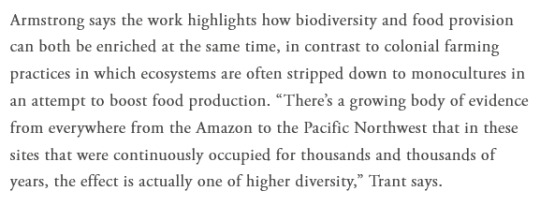
Imagine traveling back hundreds of years and finding your way up a salmon-spawning river in British Columbia to a small village. You walk into the trees and find yourself in a patch of forest dramatically different from the conifer growth around it. Small fruit and nut trees form the canopy, and there are clusters of berry bushes and cleared paths. The forest floor hosts tended herbs used for food and medicine. One child carefully peels moss from the bark of a pruned crab apple tree; another clears the ground next to a salmonberry bush.
Welcome to a temperate forest garden.
A new study shows that once-managed gardens like this are still distinct from -- and more biodiverse than -- the surrounding forest, even 150 years after Indigenous people were displaced by colonial settlers and the gardens abandoned. More diverse ecosystems are generally thought to be more resilient to environmental change and resistant to the incursion of alien species.

Chelsey Armstrong, a paleoecologist and paleobotanist at Simon Fraser University (SFU) in British Columbia, studied four sites: Dałk Gyilakyaw and Kitselas Canyon, both in Ts’msyen traditional territory in northwestern British Columbia, as well as Shxwpópélem and Say-mah-mit, both of the Coast Salish people of southwestern British Columbia. Each site hosted several villages that were occupied for thousands of years, up until the late 1800s. [...]
The garden plants they studied also had seeds that were about twice as large on average -- a trait typically associated with plants that bear larger fruits, which hints that people were purposely selecting for higher production.
The gardens contained 10 culturally significant species not normally found together, two of which fall completely outside their natural geographic range and were likely transplanted.
“Crab apple is a coastal species that likes its feet wet in the intertidal, and we’re finding it far inland in these sites, so people were moving them, in some cases, big distances,” says Armstrong.
“Hazelnut is doing the opposite, coming from the east and being moved toward the coast,” she adds. “We know that hazelnut doesn’t grow anywhere else in the area except for these village sites.”
Both species have enormous cultural importance to the Ts’msyen and Coast Salish people. Hazelnut packs a lot of calories into an easily picked nut that can be stored for up to five years. Crab apples, known locally as moolks, feature in origin stories of the areas, and were a high-status food stored over the winter months to supplement a fish-heavy diet.
“It’s amazing to think that the decisions that were made 150 years ago around stewardship and management persist today,” says Andrew Trant, an ecologist at the University of Waterloo in Ontario who was not involved with this study. The work shows that “what we do today has the potential to be persistent six generations from today.”

Armstrong says the work highlights how biodiversity and food provision can both be enriched at the same time, in contrast to colonial farming practices in which ecosystems are often stripped down to monocultures in an attempt to boost food production. “There’s a growing body of evidence from everywhere from the Amazon to the Pacific Northwest that in these sites that were continuously occupied for thousands and thousands of years, the effect is actually one of higher diversity,” Trant says.
The study details tie in with Indigenous knowledge, says Armstrong, who has been working with Indigenous partners and colleagues from the four First Nations on whose traditional territory the village sites are located: the Kitsumkalum, Kitselas, Sts’ailes, and Tsleil-Waututh. [...]
Oral histories also suggest that the job of tending forest gardens fell largely to children. Elder Betty Lou Dundas of Hartley Bay remembers pruning crab apple trees and clearing the ground around their bases to raise the trees’ productivity.
Willie Charlie, former chief of Sts’ailes, a Coast Salish First Nation, says no knowledge is ever truly lost from his community -- even after the assaults of colonialism and the residential school system.
“My grandfather said all of our teaching are still there on the land, so if somebody has a good mind and a good heart and the right intention, they can go out there and those messages are going to come to them,” says Charlie.
-------
Headline, images, captions, and text published by: Jessa Gamble. “Ancient Gardens Persist in British Columbia’s Forests.” Hakai Magazine. 9 June 2021.
3K notes
·
View notes
Text
Ancient Indigenous forest gardens promote a healthy ecosystem
https://sciencespies.com/environment/ancient-indigenous-forest-gardens-promote-a-healthy-ecosystem/
Ancient Indigenous forest gardens promote a healthy ecosystem
A new study by Simon Fraser University historical ecologists finds that Indigenous-managed forests — cared for as “forest gardens” — contain more biologically and functionally diverse species than surrounding conifer-dominated forests and create important habitat for animals and pollinators. The findings are published today in Ecology and Society.
According to researchers, ancient forests were once tended by Ts’msyen and Coast Salish peoples living along the north and south Pacific coast. These forest gardens continue to grow at remote archaeological villages on Canada’s northwest coast and are composed of native fruit and nut trees and shrubs such as crabapple, hazelnut, cranberry, wild plum, and wild cherries. Important medicinal plants and root foods like wild ginger and wild rice root grow in the understory layers.
“These plants never grow together in the wild,” says Chelsey Geralda Armstrong, an SFU Indigenous Studies assistant professor and the study lead researcher. “It seemed obvious that people put them there to grow all in one spot — like a garden. Elders and knowledge holders talk about perennial management all the time.”
“It’s no surprise these forest gardens continue to grow at archaeological village sites that haven’t yet been too severely disrupted by settler-colonial land-use.”
Ts’msyen and Coast Salish peoples’ management practices challenge the assumption that humans tend to overturn or exhaust the ecosystems they inhabit. This research highlights how Indigenous peoples not only improved the inhabited landscape, but were also keystone builders, facilitating the creation of habitat in some cases. The findings provide strong evidence that Indigenous management practices are tied to ecosystem health and resilience.
“Human activities are often considered detrimental to biodiversity, and indeed, industrial land management has had devastating consequences for biodiversity,” says Jesse Miller, study co-author, ecologist and lecturer at Stanford University. “Our research, however, shows that human activities can also have substantial benefits for biodiversity and ecosystem function. Our findings highlight that there continues to be an important role for human activities in restoring and managing ecosystems in the present and future.”
Forest gardens are a common management regime identified in Indigenous communities around the world, especially in tropical regions. Armstrong says the study is the first time forest gardens have been studied in North America — showing how important Indigenous peoples are in the maintenance and defence of some of the most functionally diverse ecosystems on the Northwest Coast.
“The forest gardens of Kitselas Canyon are a testament to the long-standing practice of Kitselas people shaping the landscape through stewardship and management,” says Chris Apps, director, Kitselas Lands & Resources Department. “Studies such as this reconnect the community with historic resources and support integration of traditional approaches with contemporary land-use management while promoting exciting initiatives for food sovereignty and cultural reflection.”
Story Source:
Materials provided by Simon Fraser University. Note: Content may be edited for style and length.
#Environment
8 notes
·
View notes
Photo

So fortunate to see Nancy Barnes, thanks for a place to crash last night and Disney Williams. Just a few Ts’msyen standing in front of a Ts’msyen house front at SHI. (at Juneau, Alaska) https://www.instagram.com/p/CTqesgcFJeU/?utm_medium=tumblr
0 notes
Text
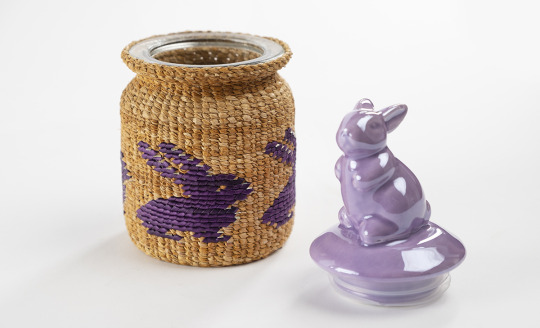


Stukwliin “Rabbit”
Kandi McGilton (Ts’msyen)
jar, woven red cedar, dyed canary grass, ceramic lid. 6.75” x 3” x 3”
24 notes
·
View notes
Text
One of our group members who lives in Washington and I talk about our Sm’algya̱x language group during the pandemic.
0 notes
Photo

Huk Dzap - The Artist
David R. Boxley
Huk Dzap – The Artist (One who’s always making/creating)
There is no direct translation from the english word “artist” into Sm’algya̱x, the language of the Tsimshian (Ts’msyen). A painter is huk’nat’miis, always painting. A carver is hukgyiłaam, always carving. I moved home to my community of Metlakatla, Alaska in 2015 to learn my language. As I now near becoming an advanced learner, I find that my approach to my art and my view on the world is changing. Using my language everyday, even for a simple title like this, is extremely important to me.
This design is meant to represent all artists. I wanted the design to be classic but modern, simple in its construction but deeply meaningful in its purpose. I chose to use primary colors in the hopes of a bold first impression, while at the same time, representing the creativity and opportunity that those colors unlock for artists today. It’s no secret that I’m a traditionalist. But this was an opportunity to use my formline training to express my appreciation for my fellow artists, of all mediums, and to express myself as a modern Ts’msyen artist.
The figure is neither male nor female, or it’s both at once. It’s the spirit in all artists that challenges us to keep creating, that inspires us. The geometric design on the left pays tribute to weavers and textile artists. The blue ultra-primary field is to represent modern materials, like glass. The hands are like paint brushes. The head ovoid, unintentional when I first designed it, is like an adze blade striking into wood.
I remember going to shows at Stonington when I was a little boy. Thanks to my father, I have had the opportunity to grow up in this art world. It’s allowed me to meet my heroes, work with some of them, and be surrounded by creativity all my life. Ayaltga’nu (I’m fortunate).
-David R. Boxley, Autumn 2019
57 notes
·
View notes
Photo


Ama g̱a̱nłaak nsipsiipnsgu, John di waayu. Ts’msyenu dił, gsbutwada di hoksgu. Nda wila waalsm. - Good morning my friends, my name is John, I’m Ts’msyen, a member of the Killerwhale clan, how are you all doing?
I am really enjoying learning to write and speak my ancestral language of sm’algya̱x. Taken last week while testing the Canon F1 (Original I acquired off my friend Ralph at work), Canon 28/2.8 FDn, using ILFORD XP2 Super
Image created on the unceded and ancestral lands of q̓ic̓əy̓ (Katzie) First Nations
#Canon F1#Canon FD 28mm f28#BelieveInFilm#ShootFilmBeNice#NorthernFilmCollective#Fraser River#katzie#katzieterritory#katzienation#fishingboats#tsimshian#tsmsyen#tsimshianphotographer#ilfordXP2#XP2Super
6 notes
·
View notes
Text
apple: Here’s why Apple has apologised to an app developer - Times of India
apple: Here’s why Apple has apologised to an app developer – Times of India
Tech giant Apple has apologised to Brendan Eshom, an app developer for indigeous language Sm’algyax, for wrongly accusing him of “dishonest and fraudulent” acts and consequently removing the app from the App Store, as per a report by Macrumours. Eshom is a freshman college student and a member of the Ts’msyen First Nation community. The app that was removed is “Sm’algyax Word”, and has been…
View On WordPress
0 notes
Text
Even 150 years later, lush forest gardens showcase the value of Native stewardship
https://sciencespies.com/environment/even-150-years-later-lush-forest-gardens-showcase-the-value-of-native-stewardship/
Even 150 years later, lush forest gardens showcase the value of Native stewardship
The way humans manage the environment doesn’t have to be destructive. In the western corner of Canada, ecologists have shown forests once tended by First Nations people are healthier and more resilient – even now, 150 years after these ancient custodians were forcibly displaced by colonial settlers.
The study is among the first to compare the Indigenous gardening practices of North America with modern-day land management, and the findings are stark.
In forests touched by recent human activity, researchers found a wood dominated by conifers and hemlocks. Whereas in the forest gardens of the Ts’msyen and Coast Salish peoples, the team found a diversity of native fruit and nut trees, including crabapple, hazelnut, cranberry, wild plum, and wild cherries.
In the gardens’ undergrowth, they also noticed a spread of wild ginger and wild rice root.
“These plants never grow together in the wild. It seemed obvious that people put them there to grow all in one spot—like a garden,” says ethnobiologist Chelsey Geralda Armstrong from Simon Fraser University in British Columbia.
“Elders and knowledge holders talk about perennial management all the time. It’s no surprise these forest gardens continue to grow at archeological village sites that haven’t yet been too severely disrupted by settler-colonial land-use.”
It’s generally accepted that agricultural practices in North America’s Pacific Northwest arrived with the dawn of colonization, but that’s simply not true.
Over the years, archaeologists have found extensive evidence of ancient forest gardens in this part of the world, and yet it’s taken us until now to truly study the environmental impact of this millennia-long stewardship.
The first real research in British Columbia (BC) now suggests these gardens have helped build and benefit the ecosystem in ways that are still apparent today.
The study focuses on two Ts’msyen villages in northwestern BC and two Coast Salish complexes in southwestern BC, which were occupied until the late 1800s.
When the authors compared the ecological function of each site to its peripheral forests, they noticed the gardens produced significantly larger and more fertile seeds, had more shade-tolerant plants and were home to more insect-pollinated and animal-pollinated plants.
The forest gardens were also richer in plant species overall, with edible fruits making up 80 percent of that extra diversity.
The discovery suggests Canada’s First Nations people were tending and translocating plants near their villages for food and medicine while also providing habitat for mammals like moose, bear, and deer, as they still do to this day.
“The forest gardens of Kitselas Canyon are a testament to the long-standing practice of Kitselas people shaping the landscape through stewardship and management,” says Chris Apps, the director of lands and resources for the Kitselas First Nation.
“Studies such as this reconnect the community with historic resources and support integration of traditional approaches with contemporary land-use management while promoting exciting initiatives for food sovereignty and cultural reflection.”
Nor is this just a lesson for the Pacific Northwest. Studies on Indigenous village sites and forest gardens in the Amazon, eastern Mexico, and northwestern Belize all suggest people once managed the environment for the better. Yet, these land-use legacies are rarely considered today by conservationists or ecologists.
“Although ecological studies rarely incorporate Indigenous land-use legacies, the positive effects of Indigenous land use on contemporary functional and taxonomic diversity that we observe provide some of the strongest evidence yet that Indigenous management practices are tied to ecosystem health and resilience,” the authors conclude.
We should really try learning from this impressive legacy.
The study was published in Ecology and Society.
#Environment
0 notes
Text
Apple Apologizes to Developer After Indigenous Language App Wrongly Removed From App Store
Apple Apologizes to Developer After Indigenous Language App Wrongly Removed From App Store
Apple has apologized to the developer of an app meant to promote the Indigenous language Sm’algyax after he was falsely accused of dishonest and fraudulent acts, and as a result, had the app removed from the App Store.
Brendan Eshom, a member of the Ts’msyen First Nation community, developed and published “Sm’algyax Word” on both Google Play and the App Store this past July. The app serves as…

View On WordPress
0 notes